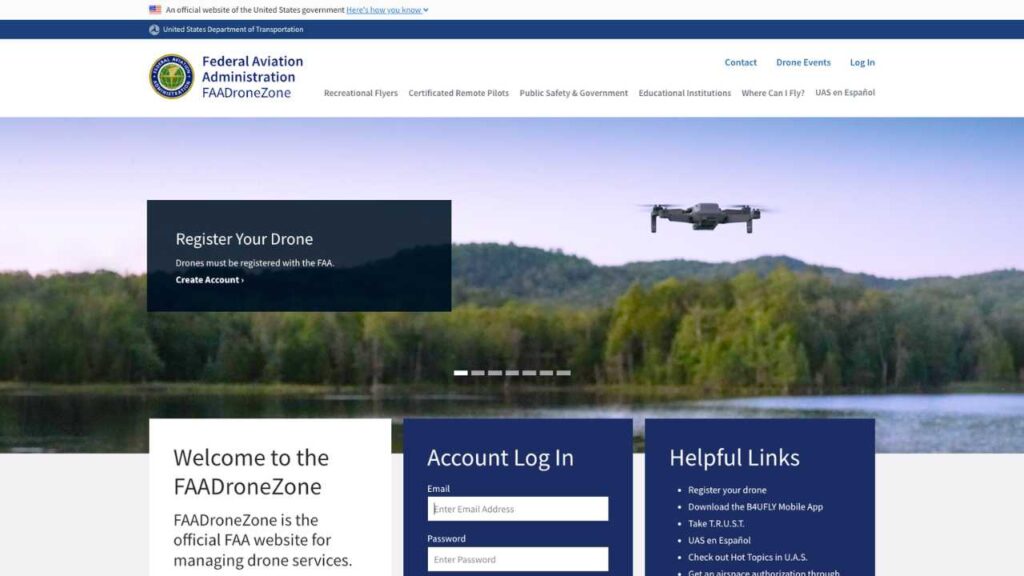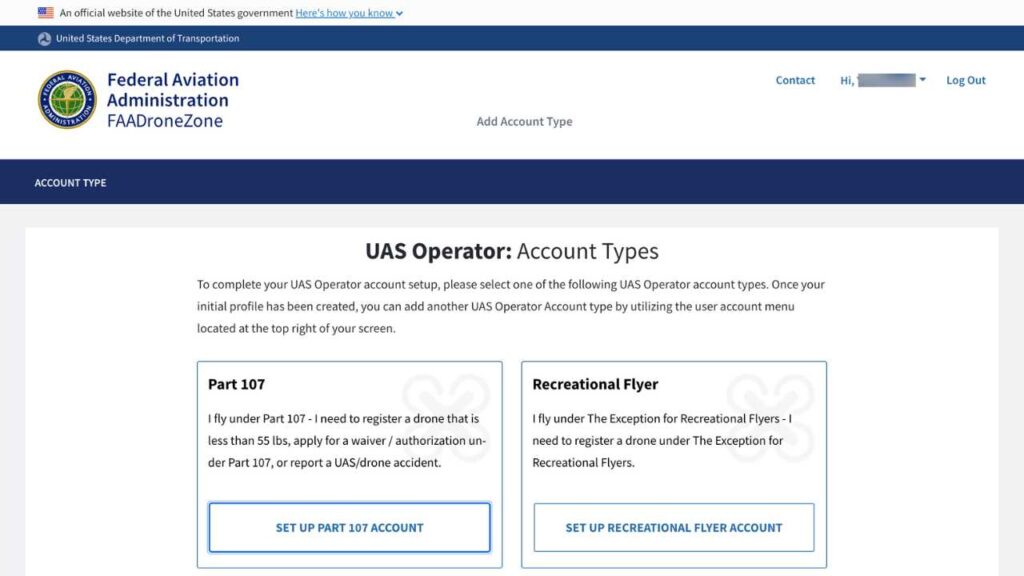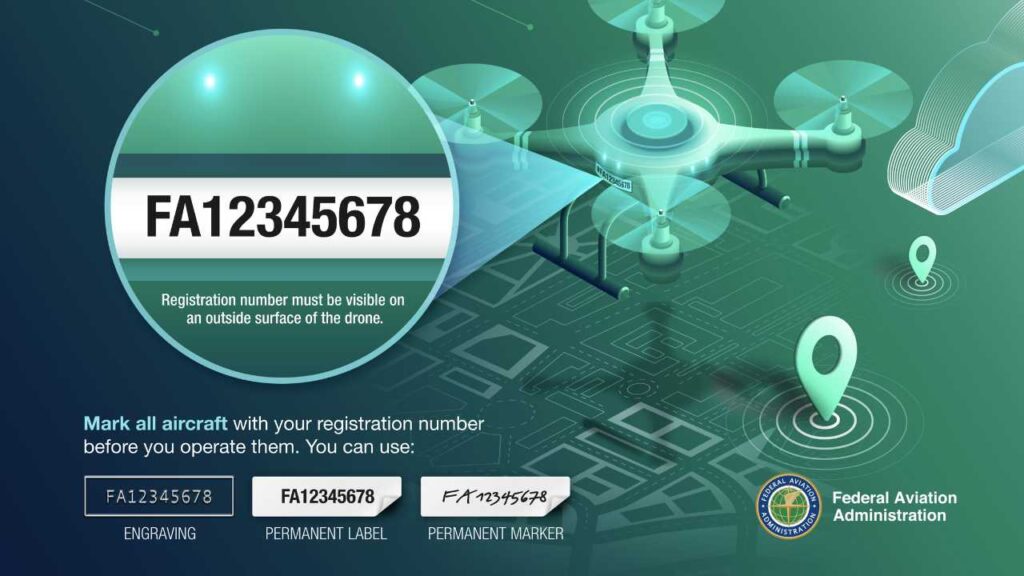
The first thing you should do after buying your drone is to register your drone with the FAA. Beware of all the misinformation regarding drone registration on the internet. Some say that you don’t need to register as long as your drone is under 0.55 lbs (250 grams). Some say you have to pay an agency for easier registration. Some say you have to take an exam to be registered.
They are all bogus or at least inaccurate. If you don’t register your drone correctly, you may incur additional costs or even a hefty fine.
That’s why I’ve put together this guide to help you register your drone properly and sensibly. Most of the information is taken from the official FAA website and summarised so that it is fact-checked.
Table of Contents
#1 Do You Need to Register Your Drone?
| Under 0.55 lbs (250 grams) | 0.55 lbs (250 grams) or more | 55 lbs (25 kg) or more | |
| Flying for Fun | No registration | Registration, Remote ID, TRUST | Mail to FAA for special permit |
| Flying for Money | Registration, Remote ID, Part 107 certificate | Registration, Remote ID, Part 107 certificate | Mail to FAA for special permit |
If You Are a Hobbyist and Fly for Fun:
- These are called recreational purposes in FAA’s definition. Whether you are an amateur or an experienced flyer, you fall into this category if you are not making money from your drone, and you are not flying for a particular purpose, like volunteering for an NGO, or inspecting your house.
- If your drone weighs less than 0.55 lbs (250 grams), you do not have to register it. However, you still have to abide by drone laws and rules. That’s why mini drones weigh less than 250 grams are so popular.
- If your drone weighs 0.55 lbs (250 grams) or more, you must register it under “The Exception for Recreational Flyers”.
- You have to take The Recreational UAS Safety Test (TRUST) online for free. But you don’t have to take the difficult Part 107 exam. You do not need the Part 107 certificate.
If You Are a Commercial Flyer and Fly for Money:
- If you make money from your drone, you fall into this category.
- Regardless of how light or small your drone is, you must register your drone. You will also need to obtain the Part 107 certificate. So, you need to study and pass the exam. Here is all about how to get a drone pilot license.
Common Misconceptions about Drone Registration:
1. My drone is a DJI Mini that weighs under 0.55 lbs (250 grams). I don’t have to register it under any circumstances.
Wrong. If you fly your drone for money, you must register with the Part 107 certificate, regardless of the weight of the drone.
2. I don’t fly for a company. Flying is not my full-time job. So I don’t need to register.
Wrong. You must register with the Part 107 certificate whether you are a full-time or part-time drone pilot.
Even if you’re flying to film your friend’s wedding, you need to get the certificate if you’re getting paid for it. If you post your videos on YouTube and turn on monetisation, you also need to get the certificate.
3. I registered my drone under “The Exception for Recreational Flyers”. So I enjoy the same rights as those who passed the exam and fly under Part 107.
Wrong. There is a greater restriction on where and how you can fly. For example, you must keep your drone in sight without relying on the camera. If you want to fly in more areas, you need to get the Part 107 certificate.
#2 Where Can You Register Your Drone?
If you google “Drone Registration” or “Register Drone”, you may find some unofficial websites that claim they can do the registration for you. But you don’t really need them.
Registering your drone is easier than you think. It’s cheap too – it only costs you $5 and it will be valid for three years. You don’t have to do $5 worth of work by paying someone $50.
If you’re flying in the US, this is the only official registration website you should visit: FAADroneZone
The domain of the official website ends with .faa.gov. And the registration websites whose domains end with .com are not real. Avoid them.
#3 What Do You Need to Prepare Before Registering?
- An email address to set up an account with the FAA.
- A physical address so the FAA can reach you or send you documents.
- A telephone number.
- A credit or debit card to pay the registration fee. It is $5 for 3 years.
- If you are flying under Part 107, which means commercial registration, you must provide the make and model of your drone.
- You must be 13 years old or older. If you are younger than 13, you must ask those who are 13 or older to register the drone.
- You must be a US citizen or a legal permanent resident. If you are a foreigner who wants to fly in the US, you can still register your drone. But you will have to pay the fee for each drone separately, regardlesss of you flying for fun or money.
#4 Step by Step Guide on How to Register

- Create an account. You will need to verify your email address.
- Choose “FAADroneZone Services”.
- Choose “Add a Service”.
- In the box of “Drone Owners and Pilots”, choose “SELECT DRONE OWNERS AND PILOT SERVICE”. Scroll to the bottom of the page, click “ADD SERVICE”.
- Click “LAUNCH DRONE OWNERS AND PILOTS DASHBOARD”.
- If you are a commercial flyer, jump to step 11.
- If you are a hobbyist, choose “SET UP RECREATIONAL FLYER ACCOUNT”.
- Fill in the form and proceed to pay the $5 fee.
- Done. You will now receive a unique registration number.
- No matter how many drones you own, if you use them for recreational purposes, you can use the same registration number. This means you only have to register and pay once.
- If you are a commercial flyer, choose “SET UP PART 107 ACCOUNT”.
- Fill in the form. You must specify your drone manufacturer and model when completing your profile.
- Proceed to pay the $5 fee. Done.
- Each registration number is only valid for a specific drone. If you have two drones for commercial use, you will need to register and pay separately. In this case, you will have to pay a total of $10.
- You must pass the Part 107 test to get the certificate before you can fly the drone.

If Your Drone Weighs 55 lbs or More:
If your drone weighs 55 pounds or more, you are technically not allowed to fly it in the US. However, you can get a special permit from the FAA depending on the business you operate.
Click on “REGISTER BY PAPER” on the home page of FAADroneZone. Follow the guide. Send the required documents to the FAA Aircraft Registration Branch.
How to Register as a Company?
If you run a business and want to register the drone, how can you do that?
You can either register the drones online via FAADroneZone using the above method, or register by paper.
If you choose the online method, a business usually registers all of its drones under the same person, whether it’s a team leader or the business owner. He or she does not have to be a Part 107 certificate holder. But those who fly the drone should be certified.
You can finish the registration in a few minutes. It costs $5 per drone. However, you may need to re-register all drones if the person no longer works for the company.
If you register your company’s drones in paper form, it will take a few weeks to complete the registration. The fee is still $5 per drone. But you can register all the drones in the company’s name. This saves you from having to re-register when you change personnel.
You must submit the Aircraft Registration Application AC Form 8050-1 in this case.
#5 What Should You Do After Registration?
Attach the Registration Number to the Drone
After registration, you will find a unique registration number on your FAADroneZone profile. Make sure it is visible on your aircraft. If you do not, you will be charged, even if you have already registered online.
Either write the registration number on a label with a felt-tip pen or print it out. Then stick the label on your drone. Make sure it is clearly visible.

You will need to replace your registration number label if it is worn or torn. You will also get a new number when you renew your registration after 3 years.
Have an FAA Registration Certificate When You Fly
Once you have registered, you will receive an FAA registration certificate. You must be able to show this when you fly, either in paper form or as a digital copy. Print out the certificate and put it in your drone bag so you can be sure you have it with you when you fly.
Don’t forget to email the certificate to yourself and save it in your phone’s camera roll. This way you can keep soft copies in case you lose your paper certificate.
Federal law requires drone operators to show their registration certificate to any federal, state, or local law enforcement officer upon request. Of course, it doesn’t apply to those who are not required to register.
Bring either a Part 107 or Trust Certificate When You Fly
If you are flying your drone for commercial purposes, you need to obtain a Remote Pilot Certificate from the FAA, which involves passing the Part 107 exam. You should carry this certificate with you when flying for commercial purposes.
If you are flying a drone recreationally, you need a The Recreational UAS Safety Test (TRUST) certificate. This is a free online education and test tool that recreational flyers must pass before they can fly their drones.
Make Sure Your Drone Has a Remote ID
Remote ID acts like a digital license plate for drones, sharing vital information such as the drone’s ID, location, altitude, speed, and where it took off from. This data helps keep the skies safe by allowing the FAA, law enforcement, and other agencies to track drones, ensuring they fly safely and legally.
To follow the Remote ID rule, drone pilots have three options:
- Use a Standard Remote ID Drone: Drones made with Remote ID capabilities that meet the rule’s standards. Most drones nowadays have a Remote ID. All you need to do is to upgrade your drone to the latest firmware.
- Add a Remote ID Broadcast Module: This device can be attached to drones, upgrading them with Remote ID capabilities.
- Fly in FAA-Recognized Identification Areas (FRIAs): The only places where drones can fly without Remote ID.
Renew Your Registration After 3 Years
Regardless of whether you register to fly recreationally or for money, your registration is only valid for 3 years. You will need to re-register your drone when your current license expires. This will cost you $5 if the price doesn’t go up in the future. Be sure to change your label and replace your certificate copies afterwards.
Tips for Finding Your Lost Drone
Once you’ve done the above, you’re ready to go. However, there is this one additional thing you can do to increase your chances of getting your drone back if it falls or gets lost.
When you label your drone, write your phone number and email address down there. So people who picked it up can contact you. Also, write down “Reward If Found” if you want to offer a better incentive.
#6 What Rules Should You Follow?
All drone pilots must follow the FAA’s Safety Guidelines regardless of which registration they choose. Even if you are not required to register, you must follow the rules.
The basic rules are:
- Register your drone if required
- Fly at or below 400 feet
- Keep your drone within your line of sight
- Obey FAA airspace restrictions
- Respect privacy
- Never fly near other planes, especially near airports
- Never fly over groups of people, public events, or stadiums with large numbers of people
- Never fly near emergencies such as fires or hurricanes
- Never fly under the influence of drugs or alcohol
Remember that you are not allowed to fly a drone in the US in any National Parks. It’s a shame. There are so many more rules that limit your creativity and enjoyment. But they are essential for the greater good.
The FAA takes unmanned aerial vehicles very seriously because they are high in the sky and can cause devastating damage to people and property below. The registration process is to ensure that drone pilots take responsibility when accidents happen. If all cars driving on the roads need a license plate, there’s no reason why drones don’t.
Thinking about it the other way around, the more we drone pilots break the rules or cause accidents, the more objectionable the image of drones will be in the future. That will lead to stricter regulations and so on. Therefore, it is our collective responsibility to be a responsible pilot and be aware of our duties.
Useful Websites and Apps
Check the website of the manufacturer of your drone. There is usually a section there called Fly Safe, which will give you a lot of useful information. Don’t forget to download the FAA’s official B4UFLY Mobile App, which shows recreational users where they can fly. You can also download another free tool called Airmap to get more details about your airspace.
Penalty
Failure to register a drone that requires registration will result in regulatory and criminal penalties. You can be fined up to $27,500. Criminal penalties include fines of up to $250,000 and/or imprisonment for up to 3 years.
If an officer catches you without registration or you fail to present your certification when flying a drone, they can fine you for that.
What to Do Next?
Now you have your drone well registered. Familiarise yourself with some basic drone skills! Don’t forget to check out our guide How to Fly A Drone to learn all the essentials!
